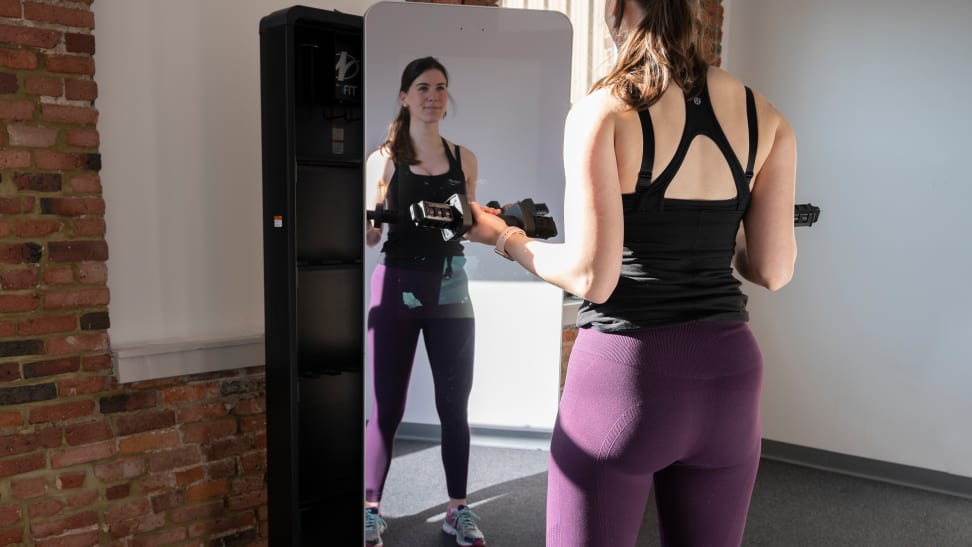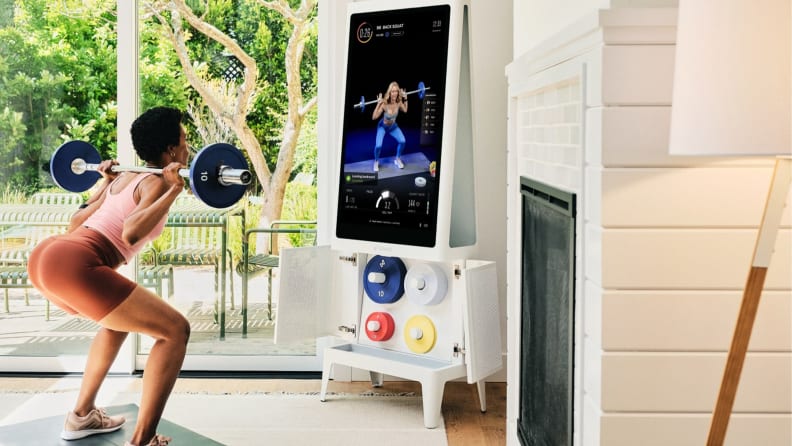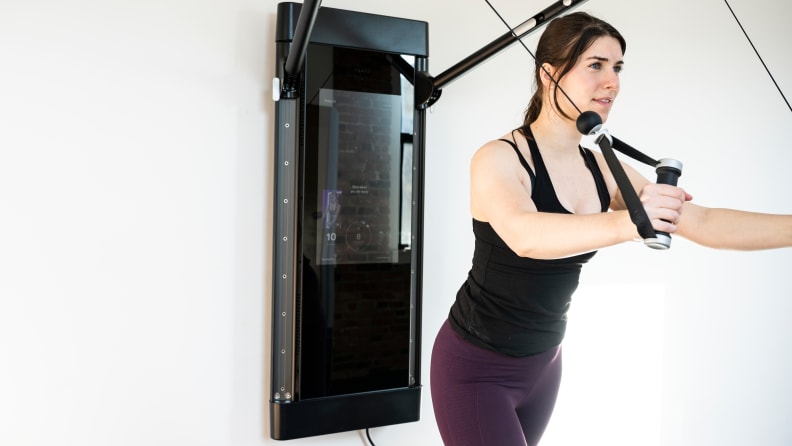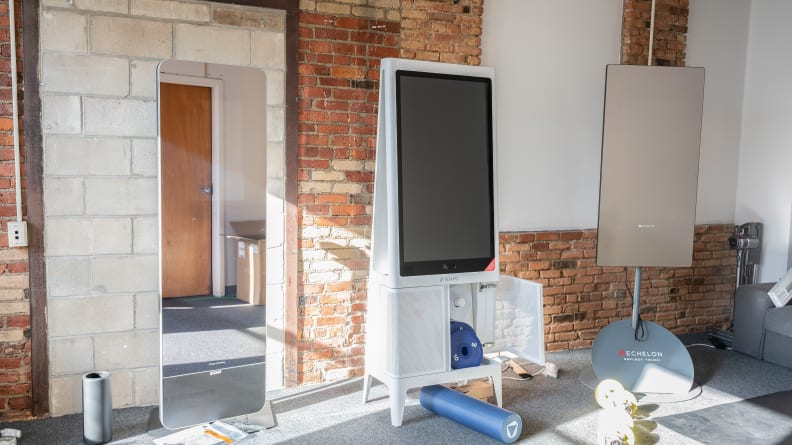 — Recommendations are independently chosen by Reviewed’s editors. Purchases you make through our links may earn us a commission.
— Recommendations are independently chosen by Reviewed’s editors. Purchases you make through our links may earn us a commission.With the rise of home workouts over the past few years, many have searched for ways to upgrade their home gym space. Enter: The workout mirror. These devices look like ordinary full-length mirrors when not in use, but when their hidden screens are powered on, you get access to a library of workout classes to stream and follow along.
We tested some of the most popular workout mirrors to find out how they stack up, and in the end we found the Tempo Studio (available at Tempo) beat the rest. We also named the Tonal (available at Tonal) our Best Upgrade, for those willing to shell out some extra dough for an all-in-one strength training system.
Here are the best workout mirrors we tested ranked, in order:
- Tempo Studio
- Tonal
- The Mirror
- Proform Vue
- NordicTrack Vault
- Echelon Reflect Touch


The Tempo Studio's AI-powered coaching helped put it on top.
The Tempo Studio topped our tests, thanks to its AI-powered virtual training, a feature few other mirrors could match. The Studio has a camera equipped with a 3D sensor that analyzes your movements to offer real-time corrections throughout your workouts and let you know when you’ve fixed your mistakes. It also counts your reps so you don’t have to.
Using the Studio is simple and fun. When you first sign up, you take a quick quiz about your preferred exercise styles and goals. From there, Tempo recommends classes it thinks you’ll enjoy and designs a training plan to help you reach your goals. I loved every class I took with Tempo. I mainly focused on strength training—to take advantage of the included weights and smart feedback—but also the occasional pilates or HIIT class. Every session had a variety of movements in it so they never felt repetitive, and all the instructors were fun, motivating, and knowledgeable. Though it would be easy for instructors to rely on the Tempo’s smart feedback, they still gave detailed guidance about how your moves should look and feel to help keep you on track.
You can take both live and prerecorded classes and can also choose from a variety of programs such as ”two-week intro to strength” or “six-week functional fitness” should you want a more structured plan. Tempo aims to personalize your class experience by recommending how much weight you should lift using the included dumbbells that start at 7.5 pounds each and come with plates to load up to 45 pounds per weight. Tempo asks whether the recommendations were too light, too heavy, or just right and will adjust accordingly. As you get stronger, it suggests heavier weights, or you can manually change your settings to your preference.
The Studio also has an optional leaderboard during class. You can get points by completing more repetitions or lifting more volume (the choice is yours) or hide the leaderboard completely. I kept the leaderboard turned off most of the time—I’m not one for competition during my workouts, but for those who get jazzed by seeing how they’re stacking up, the leaderboard could be inspiring.
Though the Studio has plenty of amazing features, it’s not a perfect system. For one, it doesn’t look like the typical workout mirror and it takes up more space than many—it has a freestanding easel shape that measures 6 feet tall and 1 foot 4 inches deep at the base and it requires you to stand 6 feet away from the 3D sensor so it can assess your form. Requiring over 7 feet from the back of the mirror to where you stand and exercise, the Studio isn’t great for small rooms. And though the form feedback is a huge plus, you only get visual cues on the screen rather than audio notifications, making it difficult to see and apply the corrections at times.
The Studio’s starter package comes with two 7.5-pound dumbbells, four 1.25-pound plates, four 2.5-pound plates, four 5-pound plates, four 10-pound plates, collars, and a yoga mat. The Plus package adds on a 25-pound barbell, a folding bench, two 25-pound plates, a foam roller, and a heart rate monitor. The Pro package throws in a folding squat rack, two 45-pound plates, and a kettlebell system that lets you use your existing plates. These weights, even at the basic starter level, allow users to get the health benefits of strength training. Tempo’s monthly membership costs $39 a month (the going rate, as set by Peloton) and allows up to six people to create an account on one device, allowing more than one user to save their stats and use the Studio to its fullest extent.
First year total cost: $2,495 (for the starter package) or $3,245 (for the plus package) or $3,495 (for the pro package) + $468 (for membership) = $2,963 to $3,963
Pros
-
Helpful AI-powered coaching
-
Great for strength training
-
Fun classes and motivational instructors
Cons
-
Requires you stand 6 feet from screen
-
Visual-only form feedback is easy to miss


For an all-in-one strength training system, Tonal is the way to go.
For a high-end connected mirror that will really level up your home workouts, consider Tonal. This wall-installed strength-training system allows users to lift up to 200 pounds using resistance cables. Though it takes some getting used to at first, in the end, I found Tonal’s cable system the easiest to use for a wide variety of workouts. No fiddling with collars or weight plates—you just slide the cable arms into position and start lifting.
When you set up the Tonal, it has you take an introductory class that shows you how to move the cables and measures your strength starting point by having you do a few key exercises such as deadlifts and bench presses. It took me a workout or two to get used to moving the cable arms, but once I got comfortable, I didn’t give them a second thought. To make things easier for you, Tonal displays small diagrams on the sides of the screen that show what position the arms should be in and what position they’re currently in, which change in real time so you can see when they line up. Tonal works by measuring your power output and when it senses a lift is getting easier for you, it increases the difficulty. I felt that Tonal gave me a good starting point—enough to challenge me but not too much—and accurately increased the resistance as I progressed.
Tonal’s classes are fun and challenging, and also the most customizable of any we tested. You can fast-forward and rewind, select your own music genre, and skip movements if you want. I was always able to find a session that looked interesting to me, but just in case, Tonal also lets you customize your own workout. You won’t have an instructor cheering you on, but you can select exercises and create your own sequence, including sets and reps. Though Tonal doesn’t use AI-powered coaching like Tempo, the device also counts your reps and will tell you if you’re moving too quickly or slowly and should focus on your form.
One of the main downsides to the Tonal (aside from its high cost) is that, like Tempo Studio, it requires 7 feet of space surrounding the machine. Though you may be able to squeeze it in with just under this, you’ll need this space to fully extend and adjust the cables and move without restriction.
The Tonal mirror is available as-is (though you’ll need your own T-lock accessory handles, which may be hard to come by), but to get the most out of it, you’ll want the smart accessories bundle, which includes a handle, bar, rope, bench, foam roller, and mat, which costs an additional $500. And though Tonal’s membership is on the higher end at $49 a month, it allows for unlimited accounts on one device, so you can share with family and friends who want to work out in your living room.
Total first year cost: $2,995 mirror + $495 smart accessories bundle + $588 membership = $4,078
Pros
-
Customizable classes
-
Takes the guesswork out of lifting
-
Fun, upbeat instructors
Cons
-
Pricier than others
-
Takes a few sessions to navigate the cables
How We Tested Workout Mirrors

We took strength, HIIT, and cardio classes to see which workout mirror had the most well-rounded programs.
We tested workout mirrors by selecting some of the most popular options available and putting them head-to-head during several rounds of testing.
The Tester
I’m Esther Bell, Reviewed’s health and fitness writer. I had never used a workout mirror before these tests, but I enjoy strength training, yoga, and pilates classes in my workout routine. When it came to testing the mirrors, I looked for high-quality options that could satisfy a wide range of users. I’ve tested plenty of equipment at Reviewed already—including adjustable dumbbells, yoga apps, and fitness trackers—so I’m familiar with the process.
The Tests
I went through the setup for each workout mirror and took different types of classes to evaluate the exercise selection, instructors, and build of the mirrors. I rated how easy it was to use them, how motivated I felt by the instruction, and how enjoyable the experience was overall. I answered targeted questions on many specific attributes and ranked each mirror on a numerical scale to find out which was the best.
What You Should Know About Buying a Workout Mirror

We tested workout mirrors from Tonal, The Mirror, NordicTrack, and more.
Workout mirrors aren’t cheap, so you’ll want to do your research before investing in such equipment. Not all of these devices look like decorative mirrors you would find at Wayfair—in fact, our top two picks are the least decorative options. While some, like the Mirror and Reflect Touch, look more inconspicuous, others stand out, often due to the more standard exercise equipment they include for you to use to get a more well-rounded workout. It’s not necessarily a bad thing—after all, you’re using these to exercise, not furnish—though something to consider if you were most drawn to getting a mirror because it wouldn’t resemble workout equipment.
Like other large cardio equipment such as exercise bikes or rowers, you’ll likely end up paying more than the advertised price. In addition to the monthly membership fees, you’ll end up buying some accessories like a yoga mat or resistance bands to make the most of your workouts.
Some mirrors can be wall-mounted, others cannot be; some must be, and others give you the choice—so you’ll want to think about where you’re going to place your mirror and how. Most also require a sizable amount of space in front of them for you to execute your exercises, so take that into consideration when deciding where to place your mirror.
You’ll also want to consider what types of exercise you enjoy. If strength training is your go-to, consider a mirror that comes with some form of resistance training gear. If you don’t see yourself lifting heavy weights, the equipment your mirror comes with may not matter so much, but instead you may want to ensure it features the types of classes you’re interested in like yoga or pilates.
Other Workout Mirrors We Tested

The Mirror—the device that started the connected workout mirror craze—is by far the prettiest of the bunch. It can be mounted on the wall or used with a stand, yet even the stand adds to its attractive aesthetic. Though the Mirror takes up almost no space on its own, any gear you use with it will need to find a home, as it doesn’t come with any storage, and you’ll still need at least a few feet of floor space—think the size of a yoga mat, enough for you to move comfortably—in front of it to do your workouts.
Like the other top options we tested, the Mirror offers a variety of workout classes. But given that I tested the Mirror in a Lululemon store (the brand acquired the Mirror in 2020) and the fact that I was chatting with the salesperson about local yoga studios, there was certainly an emphasis placed on the yoga flows.
The Mirror offers both live and pre-recorded classes, and programs should you want to dedicate yourself to one goal. Similar to Tonal, The Mirror lets users customize their workouts by changing the music settings and skipping through certain movements if needed. The Mirror also displays heart rate data (broadcast over Bluetooth from your own compatible wearable or chest strap) and other statistics during class, for those who like to keep tabs on that. The Mirror recently introduced virtual training, a feature that could be a game-changer for home workouts. For $40 a session, you can set up one-on-one sessions with a real-life trainer. While you work out in front of the Mirror, your trainer can give you real-time feedback from the other side of the screen.
The main downside to the Mirror is that it only comes with relatively light weights, which isn’t great for those who want to get stronger at home. But you get a comparatively good deal with the Mirror. You can purchase the Mirror Basic, which includes the Mirror, stand, and lens cap (for masking the camera when not in use), for $1,495. The Mirror Essentials includes a Mirror heart rate monitor, resistance bands, the Lululemon Reversible Mat 5mm, a Lululemon mat strap, the Lululemon Lift and Lengthen yoga block and the Lululemon Double Foam Roller mini for $1,695. The Mirror Pro throws in a pair of Mirror weights (which weigh your choice of 10, 15, or 20 pounds) and a Lululemon workout towel for $1,795, and the Mirror Family gives you two of everything (except the actual Mirror, stand, lens cap, and mini foam roller) for $2,045. You’ll pay $39 a month for the class membership and, like the Tempo Studio, you can add up to six profiles on one Mirror.
Total first year cost: $1,495 (Mirror Basic) or $1,695 (Mirror Essentials) or $1,795 (Mirror Pro) or $2,045 (Mirror Family) + $468 membership = $1,963 to $2,513
Pros
-
Slim, pretty design
-
Fun classes and instructors
-
Bundles allow you to customize your gear
Cons
-
Not ideal for strength training
-
No storage for workout accessories

I loved the design of the ProForm Vue, which I thought offered a great balance between form and function. From the front, the Vue looks like a simple full-length mirror. But swivel it to the side, and you can access storage for a set of dumbbells and a barbell in the back (which are included with your purchase). This means you can’t mount the Vue to the wall, but the added storage is useful and doesn’t detract from its overall appearance.
Although I loved the design of the Vue, I found the experience lacking at times. The display could be glitchy and unresponsive to touch. Like with treadmills and exercise bikes we’ve tested from ProForm and related brands, Vue users can take classes via the iFIT platform and create up to five profiles with their subscription (ProForm is owned by Icon Health and Fitness). Unfortunately, I found the iFIT classes didn’t compare to some of the other programs I tested. When taking strength training classes, instructors recommended using “heavier” or “lighter” weights, but the Vue didn’t offer a way to keep track of exactly how much I was lifting. Additionally, there was no way to fast-forward or rewind during class, a nice-to-have option if you miss something or want to skip a specific exercise. You also can’t preview the exercises in the workouts, a feature I appreciated in other mirrors, and you can’t select the music played during class, so I found myself turning the music off and listening to my own playlist instead.
Total first year cost: $1,499 mirror + $468 membership = $1,967
Pros
-
Pretty and functional design
-
Fun, motivating instructors
Cons
-
Prone to glitching
-
Less customizable classes than others

Like the ProForm Vue, the NordicTrack Vault (made by the same company) looks like effort went in to make a piece of exercise equipment look nice. The Vault is a large chest with the connected mirror on the front of the door, and while it’s bigger than many other mirrors we tested (it measures 61½ inches tall, 24¼ inches wide, and 14 inches deep), the Vault easily disguises your gear and looks more like a plain (albeit large) mirror.
Like the Vue, the Vault uses iFIT classes, so I ran into the same lack of customization. I also found the screen unresponsive at times. You can purchase the Vault “Complete” for $2,695, which includes six sets of dumbbells ranging from 5 to 30 pounds, two kettlebells weighing 20 and 30 pounds, three resistance bands and three resistance loops, an exercise mat, and two yoga blocks, or “Standalone” for $1,895, if you have your own equipment you want to store.
Total first year cost: $1,895 (Vault: Standalone) or $2,695 (Vault: Complete) + $468 membership = $2,363 to $3,163
Pros
-
Plenty of storage for gear
Cons
-
Larger than others
-
Lack of customization with classes

The Echelon Reflect Touch looks a lot like The Mirror, as it’s slimmer, plain, and doesn’t include storage for accessories. You can see stats like your heart rate zone (assuming you pair a heart rate monitor with the mirror) and calories burned at the bottom of the screen. You can take live classes, prerecorded sessions, and join multi-week programs. The classes were fun and challenging, and I thought the instructors were motivating.
Though I overall enjoyed the classes I took, I found them to be less customizable, similar to the iFit classes. Instructors said when they were picking up heavier or lighter weights during class, but there wasn’t a way to track the weight you were lifting on your profile—Echelon allows up to five user profiles with one subscription. You couldn’t change the music or skip movements, which put it behind other mirrors that give users those options. As for the design of the mirror, it looks pretty, but I found the stand unstable (though this problem could be solved by mounting it to the wall, so it may be a moot point for you).
Total first year cost: $1,499 mirror + $419.88 (billed monthly) or $399.99 (billed annually) or $699 (billed every two years) = $1,918.88
Pros
-
Upbeat instructors
-
A wide variety of classes and programs
Cons
-
Unstable stand
-
Lack of class customization
